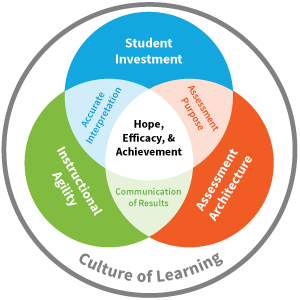
Assessment practices must build hope, efficacy, and achievement for learners and teachers. In this learning environment, the following tenets ground all of our assessment policies and practices:
- Student investment occurs when assessment and self-regulation have a symbiotic relationship.
- Student goal setting
- Student tracking of learning
- Self-assessment
- Data notebooks
- Creating hope
- Growth mindset
- Cocreating criteria
- The communication of assessment results must generate productive responses from learners and all the stakeholders who support them.
- Feedback
- Student tracking of learning
- Grades/grading
- Standards-based grading
- Standards-based report cards
- Increased motivation
- Collaborative scoring
- Students communicating their results to parents, guardians
- Student-led conferencing
- Assessment architecture is most effective when it is planned, purposeful, and intentionally sequenced in advance of instruction by all of those responsible for the delivery.
- Selected response, constructed response, and performance assessments
- Rubrics and proficiency scales
- Alignment of formative and summative assessments
- Assessment validation
- Systems alignment
- Unpacking and prioritizing standards
- Success criteria
- Learning targets
- Increasing rigor and proficiency levels
- Universal design
- Assessment purposes (formative and summative) must be interdependent to maximize learning and verify achievement.
- Validating aligned systems
- Creating protocols and tools
- Using large scale assessments, standardized assessments, district benchmarks, and classroom assessments
- Instructional agility occurs when emerging evidence informs real-time modifications within the context of the expected learning.
- Using formative data
- Creating interventions, enrichments, and re-engagement strategies
- Gathering meaningful evidence at the classroom level
- Utilizing formative strategies for daily instruction
- Employing planned hinge, reflective questions, prompts, and cues
- Analyzing data by skill and by learner
- The interpretation of assessment results must be accurate, accessible, and reliable.
- Using formative data
- Creating interventions, enrichments, and re-engagement strategies
- Gathering meaningful evidence at the classroom level
- Utilizing formative strategies for daily instruction
- Employing planned hinge, reflective questions, prompts, cues
- Analyzing data by skill and by learner
Foundation: A learning-rich culture provides opportunities for risk taking, productive failure, and celebrated successes.
C. Erkens, T. Schimmer, & N. Vagle, 2015
